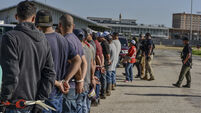Childminders provide an essential service, but it needs to be regulated
“Congratulations,” it said, “to all the kids who were born in the 1950s, ’60s and ’70s. We had survived. Our mothers smoked while they were pregnant with us. After we were born, our cots were covered with lead-based paints. We had no childproof lids on medicine bottles, doors or cabinets and when we rode our bikes, we had no helmets.
“As children we would ride in cars with no seat belts or airbags. We shared one soft drink with four friends, from one bottle, and no one actually died. We ate cakes, white bread and real butter and drank pop with sugar in it, but we weren’t overweight because we were always outside playing.
“We would leave home in the morning and play all day, as long as we were back when the streetlights came on. We would spend hours building our go-karts out of scraps and then ride down the hill, only to find out we forgot the brakes. After running into the bushes a few times, we learned to solve the problem.
“We didn’t have Playstations, Nintendos, X-boxes, no video games at all, no 99 channels on cable, no video tape movies, no surround sound, no cell phones, no text messaging, no personal computers, no internet chatrooms. Instead we had friends and we went outside and found them. We fell out of trees, got cut, broke bones and teeth and there were no lawsuits from these accidents.”
And then the email went on to say this generation has produced some of the best risk-takers, problem-solvers and inventors ever. The past 50 years have seen an explosion of innovation and new ideas. We had freedom, failure, success and responsibility, and we learned how to deal with it all. And I’m one of that generation — that’s why I deserve the congratulations at the start of the email.
And then the sting in the tail. The original author of this message (American, I’m guessing) says: “You might want to share this with others who have had the luck to grow up as kids before the lawyers and the government regulated our lives for our own good.”
Stop right there, I thought. Nostalgia’s great, isn’t it? It enables us to put a rosy glow around everything, to imagine things as we would like to remember them. But is it really the case that the world was wonderful until lawyers and governments started regulating our lives for our own good? I was delighted over the past weekend to have been asked to speak at a conference of childminders in Dublin.
Childminders, in this context, are people (usually women) who mind up to three or four children in their own homes. It’s a career for many of them, and it’s one they take seriously and do outstandingly well. Because they take their careers so seriously, they are performing a valuable service for other families, for the community and for the economy. They make a large number of childcare places available that would be neither there nor affordable without them, and they do it with great care.
But they live in a largely unregulated world where notification is voluntary, where the standards they apply are their own, where there is no real inspection of their premises or the arrangements they are making.
Of course, introducing regulation into this world of childminding in the home would be intrusive, and it would also be potentially expensive if it weren’t managed well. But the absence of any regulation whatever has to be a source of worry.
I spoke to the childminders about resilience in children. It’s an elusive quality, resilience, and it’s vital, because it’s the thing that enables children to cope with adversity.
As you think about resilience, or live with it, or experience it in your work, one thing becomes painfully obvious: you can’t teach resilience. If the seed is there, you can help it grow. But if it’s not there, no amount of instruction, therapy or intervention will impart that vital human quality.
And what is the seed? Where is it to be found?
In an article he wrote in 2000 in Children and Society, Prof Robbie Gilligan said “a single experience or episode, a positive relationship even short-lived — perhaps the impact of a sports coach in a summer coaching scheme, or of a short-term foster-carer who opens up new self-belief, or a teacher who in one year lays a foundation of confidence — can be a turning point”.
He went on in that article to talk about the three factors that contribute most to resilience — the sense of having a secure base, a sense of self-esteem and a sense of self-efficacy that can come from responsive and encouraging parenting. All three factors, of course, derive in the first instance from something within ourselves, but just as importantly from the relationships that help the seed to grow.
In a book called The Secure Child, Stanley Greenspan describes a study of Hawaiian children who had grown up in adversity. Those children who got on, despite the difficulties they encountered, all had one thing in common, a hidden strength as Greenspan called it.
That hidden strength was neither physical nor intellectual — in fact it was access to a nurturing and supportive relationship with a relative or someone else, perhaps a person who lived across the way or nearby in the neighbourhood.
ACCORDING to Greenspan, resilience emerged in this study not as a state of mind, but as a reflection of the relationships available to the child. And childminding, unregulated as it is, can often contribute to a key relationship — the sort of relationship that can instil lasting memories and capacities in a child, or indeed can do serious damage.
I’ve written here before about other “childminding” places, like the Baltimore School, whose savagery and cruelty to children endured until the 1950s, and are graphically described in the Laffoy Commission reports.
Many children survived that hellhole and other places like it. But many were damaged. Nonetheless some survivors have described how the distant memory of love in their mother’s arms helped to sustain them through the hell of institutional abuse.
The Baltimore School, incidentally, wasn’t run by “lawyers and the government”. The governors of Baltimore School during all this period of savagery were the bishop of Cork and Ross and the parish priest of Baltimore, although the school was subjected to regular inspections by departmental inspectors.
I’ve often wondered if those people really believed that the best way to build resilience in children was to beat it in to them.
Yes, things were great when I was a kid — for a lot of us. Neighbourhoods were often better places then, family was closer, there were different attitudes to discipline. But the values of those days allowed kids to be tortured, too, and their torturers to get away with it. The past is a different place — not always a better one.















